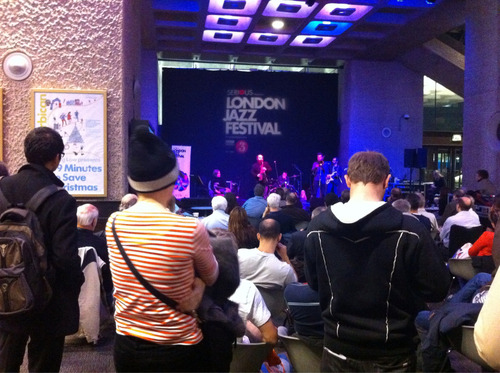
How was the London Jazz Festival for you?
There could be a hundred or a thousand answers to this question.
Ten days of gigs, with innumerable permutations in gig going, pre-concert talk to-ing, and post-gig foyer fro-ing, as well as films, afternoon shows, late night jamming in the clubs and concert halls of the capital, saturated London with jazz dominating in central London especially with additional pockets of heightened activity in the suburbs.
Big names
Yes, there were lots this year, none bigger than Sonny Rollins and Herbie Hancock, but there were also a great many unknown or little known European names, and many young and established bands from the UK scene taking part, some for the first time.
Venues
While some venues from last year did not take part, Boisdale Canary Wharf the most high profile of these, others took their place, but the festival hubs in terms of concert hall activity are clearly at the South Bank Centre and the Barbican. The clubs saw a huge amount of high quality activity, but it was Ronnie Scott’s, the Vortex, and the Pizza Express Jazz Club that were upper-most on many people’s wish lists.
Buzz?
I attended about half a dozen events this year, and I’m sure many people attended many more concerts, or even considerably fewer. It struck me that there is a big difference in feel between the ticketed big concert hall events and freestage activity. Audiences in both the Festival Hall and the Barbican were generally quite subdued and polite whereas in the foyers for freestage and Clore Ballroom gigs the atmosphere was more casual, more sociable, and it felt as if large numbers were sampling new acts that they would be unlikely to attend in such large numbers on a whim parting with hard cash. Hopefully, a percentage of these audiences will return for ticketed concerts in the future if the new bands they saw gain a following. With a band such as Finnish hopefuls Oddarrang, for instance, that could well happen given the response they received on the SouthBank.
The future
How the BBC and Radio 3 will be involved next year for the festival’s 21st running remains to be seen as the “in association” sponsorship the festival has enjoyed comes to an end. But one would presume that the corporation will broadcast heavily at the festival whether it is a headline sponsor or not. With radio coverage and web reviews via blogs and social media and to a much lesser extent print media the festival made its presence felt, but given the epic size of the event this was still paltry compared to say the acres of media attention London Fashion Week, the Proms, and the London Film Festival receives.
Too big?
It may be a controversial thing to say that the festival is now too big to make sensible choices, and it’s just another aspect of the plentiful array of entertainment in London. If gig-goers start to clamour for an intimate festival of some kind as an alternative then the chances are the festival has bulked up that bit too much. If they don’t then big is, for London jazz fans, most certainly beautiful.
Stephen Graham
View from the foyer above at the London Jazz Festival in the Barbican last week